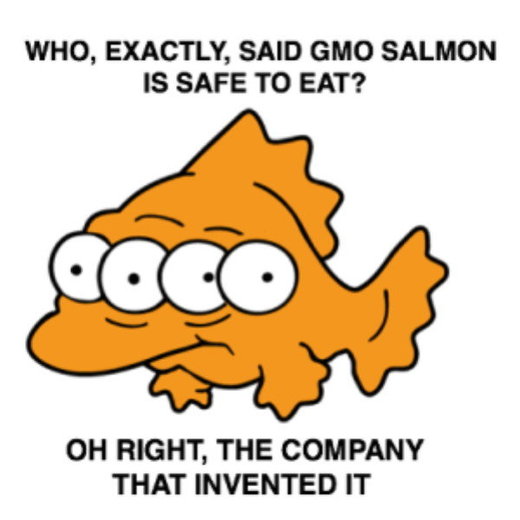Last November, the FDA cleared GM salmon after a 20-year approval process, making salmon the first genetically modified animal slated for human consumption. Under the original provisions of the clearance, the salmon, known as AquAdvantage salmon and produced by the Massachusetts-based AquaBounty Technologies, would not have to be labeled as a GM product. Consumer groups responded with outrage that they might unknowingly consume what they dubbed "Frankenfish."
AquaBounty said their fish was nutritionally identical to regular salmon and tasted the same, and the FDA agreed. The company presented its salmon as a sustainable alternative to wild or traditionally farmed salmon, which are vulnerable to overfishing and disease outbreaks. AquAdvantage salmon, a cross between a Chinook salmon and ocean pout, are grown indoors in Canada and Panama and reach adult size in half the time as regular salmon.
Their assertions about the fish's safety did little to assuage some environmental, consumer, grocery, and fishing groups. Environmentalists worried about what would happen if a GM salmon escaped into the wild and bred with wild fish; dozens of grocery chains committed to not carrying the AquAdvantage salmon in their stores to appease consumer groups; and fisherman and fish farmers worried about a collapse in salmon prices.
On the other side of the coin, some scientists looked at the approval as a major breakthrough for human agriculture and a recognition of the 10,000-year tradition of genetic manipulation by farmers. As for a fish escaping into the wild and mixing with a wild fish population, AquaBounty said that was virtually impossible, as its fish—all female—were sterilized, with just a tiny failure rate in the procedure, and multiple barriers and filters prevented their escape.
Comment: The GMO technology that created the Frankenfish is NOT a 10,000-year tradition of genetic manipulation by farmers. It is mad science, where animals are manipulated in a lab with untested consequences to human health, animal welfare and the environment. The following are just two recent examples of biotech mad science gone wild:
But the opposition pushed on, and Alaskan Senator Lisa Murkowski argued fiercely to include clauses prohibiting the import and sale of AquAdvantage salmon in the federal spending bill introduced in December and recently passed. The language directed the FDA to prevent AquAdvantage salmon from making it to US shelves until a labeling solution had been reached, and ordered the agency to spend "not less than $150,000" doing so. The FDA followed through on the order on Friday.
"This is a huge step in our fight against 'Frankenfish,' Murkowski said in a statement. "I firmly believe that mandatory labeling guidelines must be put in place as soon as possible so consumers know what it is they are purchasing."
Murkowski said she was "livid" about the FDA approval, and threatened to block the appointment of the next FDA commissioner over their decision. Alaska's seafood industry contributes 78,500 jobs and nearly $6 billion to the Alaskan economy annually, and the state is home to some of the largest salmon populations in the world.
AquaBounty has appeared non-plussed following the ruling, with its CEO saying it "has no impact on AquaBounty's operations as we are not currently importing our salmon into the United States."
Those looking to try the US's first GMO animal will have to wait. As anyone who's ever spent time sitting on a dock staring at a bobber knows, fishing requires patience.




Comment: Freakiest Things About Frankenfish: